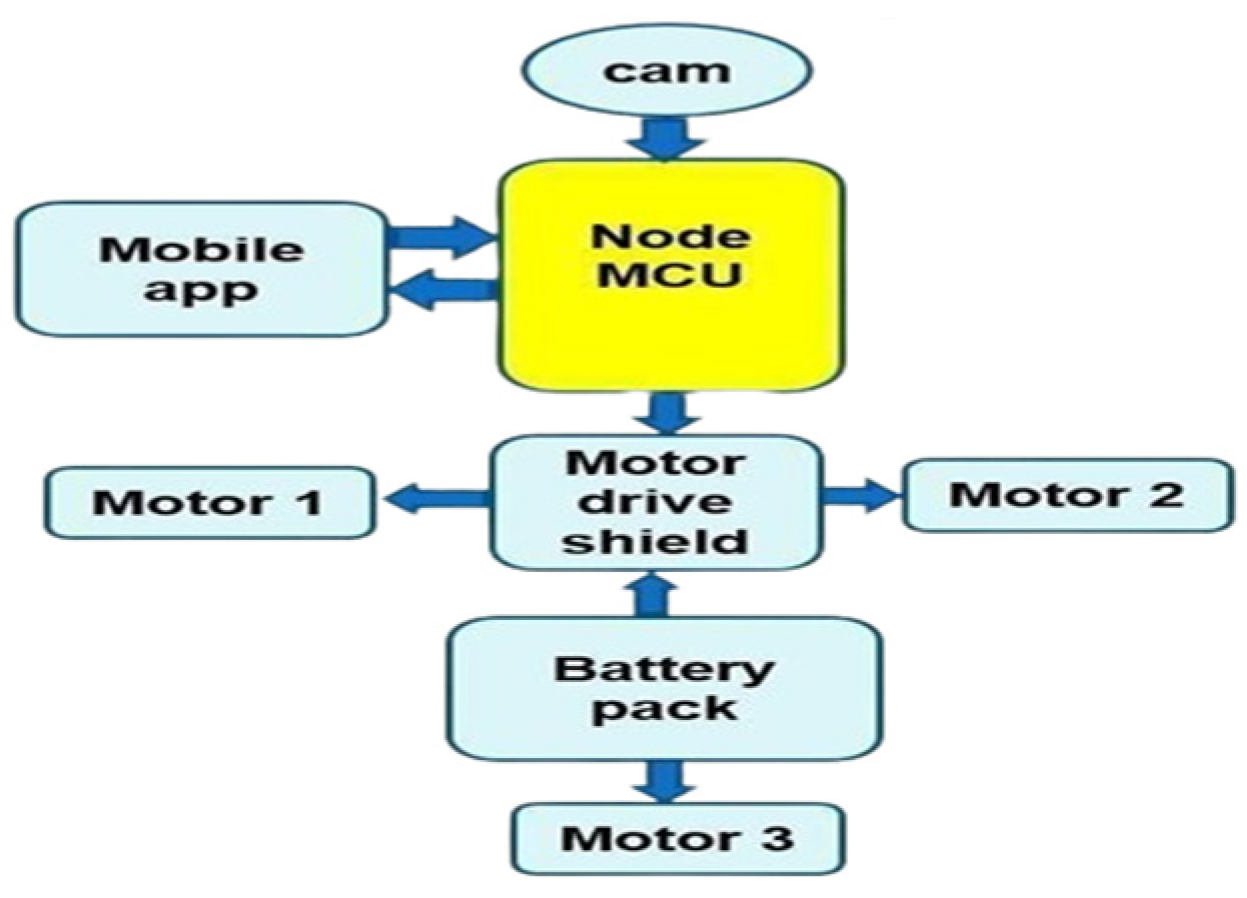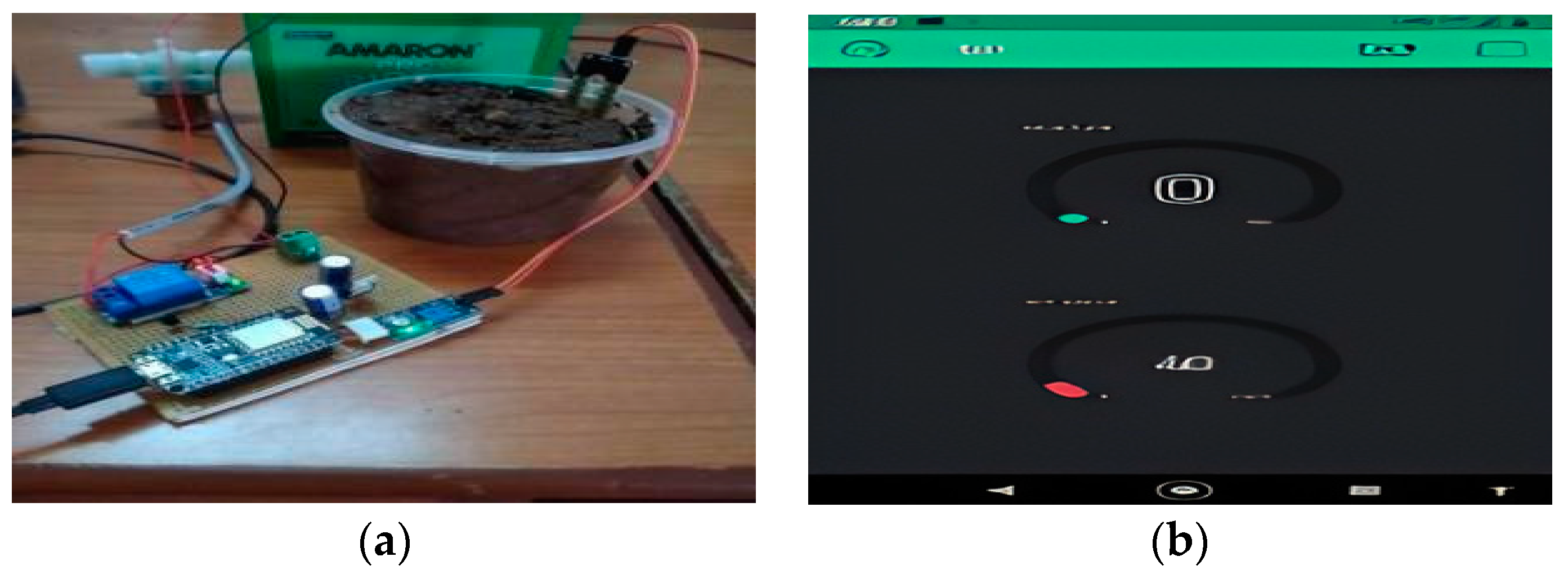An IoT-Based Smart Irrigation System †
Abstract
1. Introduction
2. Components and Their Functions
2.1. DC Motor
2.2. Soil Moisture Sensor
2.3. Battery
2.4. Capacitor
2.5. NodeMCU ESP8266
2.6. Water Pump
2.7. Diode
3. Flowchart of the Smart Irrigation System
4. Block Diagram
- Humidity section: two humidity sensors are placed here to help record the humidity level.
- Control section: Here we have Arduino UNO and a modem, where Arduino helps to start the pump (motor) and the modem helps to communicate with the mobile.
- Part of IoT: Here we talk about cloud servers, the online use of images and data, and web pages that help save the data. This is performed using the think blynk application.
- Functionality: Users can view information using the application. If the sensor is not working, farmers can use their phones to control the engine.
5. Software Implementation
6. Hardware Implementation
7. Existing Method
8. Proposed Method
9. Results and Conclusions
10. Future Scope
Author Contributions
Funding
Institutional Review Board Statement
Informed Consent Statement
Data Availability Statement
Conflicts of Interest
References
- Abayomi-Alli, O.; Odusami, M.; Ojinaka, D.; Shobayo, O.; Misra, S.; Damasevicius, R. Smart-Solar Irrigation System (SMIS) for Sustainable Agriculture. In Applied Informatics; Florez, H., Diaz, C., Chavarriaga, J., Eds.; Springer International Publishing: Cham, Switzerland, 2018; Volume 942, pp. 198–212. [Google Scholar]
- Boursianis, A.D.; Papadopoulou, M.S.; Gotsis, A.; Wan, S.; Sarigiannidis, P.; Nikolaidis, S.; Goudos, S.K. Smart Irrigation System for Precision Agriculture—The AREThOU5A IoT Platform. IEEE Sens. J. 2021, 21, 17539–17547. [Google Scholar] [CrossRef]
- Stolojescu-Crisan, C.; Butunoi, B.P.; Crisan, C. An IoT Based Smart Irrigation System. IEEE Consum. Electron. Mag. 2022, 11, 50–58. [Google Scholar] [CrossRef]
- Mogili, U.R.; Deepak, B.B.V.L. An intelligent drone for agriculture applications with the aid of the MAVlink protocol. In Innovative Product Design and Intelligent Manufacturing Systems: Select Proceedings of ICIPDIMS 2019; Springer: Singapore, 2020; pp. 195–205. [Google Scholar]
- Raja, M.; Nithish, N.M.; Shankar, B.S.; Sadhurwanth, D. Automatic Irrigation and Crop Protection System Based on IoT. In Disruptive Technologies for Big Data and Cloud Applications; Peter, J.D., Fernandes, S.L., Alavi, A.H., Eds.; Springer: Singapore, 2022; Volume 905, pp. 355–363. [Google Scholar]
- Tephila, M.B.; Sri, R.A.; Abinaya, R.; Lakshmi, J.A.; Divya, V. Automated Smart Irrigation System Using IoT with Sensor Parameter. In Proceedings of the 2022 International Conference on Electronics and Renewable Systems (ICEARS), Tuticorin, India, 16–18 March 2022; IEEE: Piscataway, NJ, USA, 2022; pp. 543–549. [Google Scholar]
- Garg, D.; Alam, M. Smart Agriculture: A Literature Review. J. Manag. Anal. 2023, 10, 359–415. [Google Scholar] [CrossRef]
- Gamal, Y.; Soltan, A.; Said, L.A.; Madian, A.H.; Radwan, A.G. Smart Irrigation Systems: Overview. IEEE Access 2024, 1-1. [Google Scholar] [CrossRef]
- Mogili, U.R.; Deepak, B.B.V.L. Study of takeoff constraints for lifting an agriculture pesticide sprinkling multi-rotor system. In Advances in Materials and Manufacturing Engineering: Proceedings of ICAMME 2019; Springer: Singapore, 2020; pp. 203–210. [Google Scholar]




Disclaimer/Publisher’s Note: The statements, opinions and data contained in all publications are solely those of the individual author(s) and contributor(s) and not of MDPI and/or the editor(s). MDPI and/or the editor(s) disclaim responsibility for any injury to people or property resulting from any ideas, methods, instructions or products referred to in the content. |
© 2024 by the authors. Licensee MDPI, Basel, Switzerland. This article is an open access article distributed under the terms and conditions of the Creative Commons Attribution (CC BY) license (https://creativecommons.org/licenses/by/4.0/).
Share and Cite
Muthuramalingam, R.; Rathnam Velu, R.; Baskar, H.; Vellan Saminathan, M.H. An IoT-Based Smart Irrigation System. Eng. Proc. 2024, 66, 13. https://doi.org/10.3390/engproc2024066013
Muthuramalingam R, Rathnam Velu R, Baskar H, Vellan Saminathan MH. An IoT-Based Smart Irrigation System. Engineering Proceedings. 2024; 66(1):13. https://doi.org/10.3390/engproc2024066013
Chicago/Turabian StyleMuthuramalingam, Raja, Reshnuvi Rathnam Velu, Harshini Baskar, and Merun Hrithik Vellan Saminathan. 2024. "An IoT-Based Smart Irrigation System" Engineering Proceedings 66, no. 1: 13. https://doi.org/10.3390/engproc2024066013
APA StyleMuthuramalingam, R., Rathnam Velu, R., Baskar, H., & Vellan Saminathan, M. H. (2024). An IoT-Based Smart Irrigation System. Engineering Proceedings, 66(1), 13. https://doi.org/10.3390/engproc2024066013





